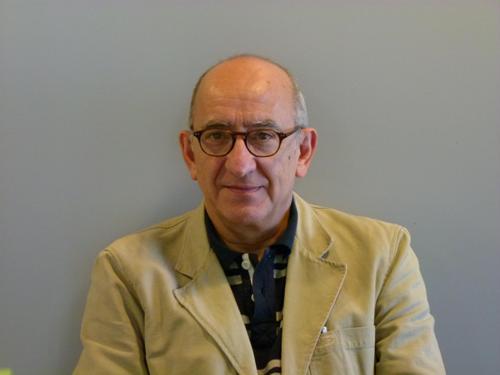PEDRO CLEMENTE MARIJUÁN
While there is still no scientific consensus on what "life" is -- although that does not deter attempts to make life in the lab -- there is a growing conversation among scientists about life's "information" component. However, scientists also find it difficult articulating just what information is. So I phoned information scientist Pedro Clemente Marijuán in Spain to explore the subject. Marijuán's current research interests include "the nature of intelligence and the nature of information, at the molecular-cellular and organismic (brain) levels."
Pedro Marijuán is Senior Research Scientist at Spain's Aragon Institute of Health Sciences (IACS) where he heads the Bioinformation Group. He has also served as IACS Research Director (2011-2015).
In 1991, Marijuán co-founded FIS (Foundations of Information Science) with theoretical biologist Michael Conrad. Marijuán says one of the missions of FIS is "organizing a sound body of new thinking about the informational cohesion of the physical, biological and social realms" of science. He is also Vice-President for Protocol of the International Society for Information Studies (IS4SI).
Pedro Marijuán's professional career began as an industrial engineer in the 1970s in Spain, working with computers in "enterprise organization," after receiving his undergraduate degree in engineering from the Polytechnic University of Catalonia. Later inspired by John von Neumann's ideas, Marijuán began his own investigations into cognitive neuroscience, which led to his PhD (University of Barcelona, 1989): "On Natural Intelligence: The Evolution of Biological Information Processing." In the early 1990s he was a Visiting Research Associate at the University of Chicago, working with microbiologist James Shapiro, as well as at the University of Canberra.
Marijuán has taught engineering at the University of Zaragoza and is former SAMCA Chair at the Engineering School, University of Zaragoza.
Through the years Pedro Marijuán has organized and co-organized international conferences on information science in Madrid, Vienna, Paris, Beijing, Gothenberg (upcoming, 2017) and elsewhere, and a regular series of seminars in Spain on biomedicine and neuroscience.
He is author of the book, The Dual Brain and numerous other scientific publications, editor of "Cajal and Consciousness" (Annals of the New York Academy of Sciences) and of special issues on FIS published in the journals BioSystems and Symmetry: Culture and Science as well as of "Selected Papers from 'FIS 2010 Beijing.'"
One of Pedro Marijuán's other principal interests is understanding the sound of laughter, its structure, and using that information as a diagnostic tool in biomedicine. Our interview follows.
Suzan Mazur: In between your careers as an industrial engineer and cognitive neuroscientist, you were a visiting research associate at the University of Chicago in the early 1990s, working with microbiologist James Shapiro. That's quite a range of expertise. What sort of research were you doing with Jim Shapiro in Chicago?
Pedro Marijuán: I was advancing an informational scheme of the prokaryotic cell in relation to James Shapiro's interest in developing new evolutionary ideas. At the same time I was learning real biology from James -- I personally thank him for his hospitality and patience. However, I realized I needed stronger insights into the molecular machinery of the cell and into enzymes and proteins, so I began collaborating with biophysicist and theoretical biologist Michael Conrad as well as with enzymologist John Westley.
Both were relatively close to James Shapiro's interests. Michael Conrad was especially influential; Michael pioneered molecular computing and adaptability in ecological information processes. He looked beyond science in his work to philosophy, art, and literature.
Suzan Mazur: Please tell me a little about your current research interests.
Pedro Marijuán: Here at the Aragon Institute of Health Sciences (IACS) in Zaragoza, I'm investigating cellular signaling systems, social bonding, and human laughter. I and my small bioinformation group -- Jorge Navarro and Raquel del Moral -- are interested in studying everything alive that communicates: cells, organisms, people, and the way human society is structured through social bonds, i.e., language -- talking face-to-face, by phone, texting, etc. Because it's through language that human society evolved, grew complex and interesting.
People do need to talk to one another. If we don't speak, we don't feel well. Isolation is the worst scenario for human beings. Language, which was at first instrumental in humans, eventually became a necessity.
How much do people need to talk? And to whom? I'm interested in how people and communities build and maintain societal bonds through conversation and what the consequences are when that natural communication process goes awry.
To thrive, humans need to immerse themselves in social layers: An intimate layer ("family"), close friends, work relationships as well as general acquaintances. These bonds form a person's "sociotype." We have not only a genotype and phenotype, but also a "sociotype."
Suzan Mazur: Is this layering a perspective from your background in engineering?
Pedro Marijuán: Perhaps. I was an industrial engineer here in Spain during the 1970s, working with computers, in the field of "enterprise organization." I got terribly excited about the possibility of similar information processes in the human brain and in society. Then I read John von Neumann's book comparing the human brain to a computer. I began to realize the informational scheme of the single cell was missing in the scientific literature. I began doing informal research and wrote some newspaper articles, which eventually led to my PhD ["On Natural Intelligence: The Evolution of Biological Information Processing"].
Suzan Mazur: IACS, where you're currently Senior Research Scientist -- this is an organization focused on biomedical research?
Pedro Marijuán: IACS and its germane organization IIS Aragon cover all areas of biomedical research for the main hospitals in the Aragon region. Until the political change last year, I was Director of Research in charge of organizing teams, and focused on the many problems biomedical research has. I was reassigned as IACS Senior Research Scientist.
Suzan Mazur: Information science research.
Pedro Marijuán: Actually our group looks to find ways to apply information science to biomedicine. For example, we use information science as a diagnostic tool to study changes in the sound of laughter of depressed individuals. We've used it with EEG records, and to look for objective markers in fibromyalgia. We've also designed a questionnaire to gauge the sensitivity of the individual state of the sociotype. It's particularly helpful for the elderly because they suffer a lot from loneliness.
Suzan Mazur: You first wrote on the informational patterns of laughter 10 or so years ago. What was the thrust of that paper?
Pedro Marijuán: I highlighted the social role of laughter and peculiarities of the structure of the sounds of laughter. We've written four or five scientific papers on laughter since then. Laughter is a very, very strategic way of communicating. It connects the physiological, psychological, cognitive, emotional and social. Laughter tells a lot about a person and their environment. It's highly personal.
Why is someone laughing? Laughter may be particularly beautiful -- or out of context. Why is that? What are the main sound components we instinctively scan when we laugh? What is the emotional code attached to laughter?
Suzan Mazur: It's interesting that comedy in America used to be spontaneous, quite funny, a healthy release of tension. We had comedy from the Borscht Belt, Sid Caesar, Steve Allen, early Woody Allen, 1970s Saturday Night Live. Michael O'Donoghue -- the comedic genius behind SNL -- was a friend of mine. By the late 70s, Michael thought SNL was no longer funny. Roughly around the time he left the show. That's not a joke, by the way. Comedy now in America, at least, seems uninspired, a captive of its commercial sponsors.
Pedro Marijuán: Yes. I agree with you. I don't follow media much, but it's clear that individuals are now overloaded with new kinds of artificial information flows. When a person is systematically suffering information overloads, humor is a kind of canary in the mine, a barometer. Entering the mine, the canary dies or not. Humor, or lack of it, is an indicator of individual mental health and happiness, of a person's relationship to their social contacts and of societal health.
We are seeing a rise in the number of depressed patients. We see an amazing increase in the number of people living alone. We are witnessing the accelerated loss of what Robert Putnam calls "social capital."
The information revolution is contributing to these problems -- introducing surrogate bonds via new technologies that capture a growing portion of a person's time. People are alone, going from screen to screen, abandoning long-term rewards of face-to-face conversation, endangering their social bonds. Our very social nature is being denied, or mystified, and our sociotype is becoming dramatically flattened.
Suzan Mazur: I've interviewed Jaron Lanier, the "father of virtual reality" who has said regarding the digital world that humans may have taken a wrong turn for the right reasons and he predicts artificial intelligence ideology will reach a breaking point in Europe, but "the US will break first certainly, as we'll find out." His thinking is that human job displacement due to computerization and robotics will lead to a welfare state that can't be sustained.
Pedro Marijuán: Something similar happened with the first industrial revolution, with the second industrial revolution, and now we are suffering the consequences of the information and computer revolution. We have not developed the tools to successfully integrate all these artificial information flows with our natural information flows. The adaptability of our social nature, of our sociotype, has been pushed to the extremes.
In my info science parlance, the artificial flows of information that are reshaping the structures of our societies at tremendous speed are blind to the natural info flows to which our modest individual lives are upended. "No one to talk with? Do not worry, here's a pet robot that will fill your nostalgic needs of social bonding."
The power structure does not care about impoverishing people throughout the world through tremendous economic disruption and loss of intermediation structures; it pushes for even more disruption, impervious to the social crisis.
It is urgent that we provide a new vision for human society because this disruption and endangerment of our natural information flow touches us deep, into our cells. Science has been particularly influential in creating these strange new problems -- and in leaving them unchecked! Science must now help find the conceptual tools to address this social unease all around us.
Suzan Mazur: Would you talk a little bit about your role as chair of the Foundations of Information Science and would you define what you mean by the term "information"?
Pedro Marijuán: I co-founded the Foundations of Information Science with Michael Conrad more than 20 years ago -- we coined the name FIS in 1992. Michael Conrad was a very great man, enormously enthusiastic and engaging. Among Michael's many contributions to science, he was one of the first to attempt an evolutionary model of the "vertical information flow" in brain behavior. He passed away in 2000. Michael brought most of the specific scientific content to FIS, while the multidisciplinary vision of FIS was largely mine.
Suzan Mazur: What do you mean by the term "information"? I once interviewed physicist Sara Walker on the subject. She's a collaborator of Paul Davies at Arizona State University. Walker defined information as "events that affect and direct the states of a dynamic system." How do you define it?
Pedro Marijuán: The term is really undefinable because it's a relative term concerning the interaction between two entities -- the object and the subject. My favorite definition is "distinction on the adjacent." You cannot have an informational relationship with anything that does not "touch" you in some way. In order to make any distinction, something has to be "adjacent" to you.
This is biologically meaningful. I've based my informational scheme of the cell on this thinking of "distinction on the adjacent" -- where molecular recognition is the essential phenomenon over which biological complexity has been developed.
Myriad distinctions are factually created in the different adjacency relationships between biomolecules within the living cell, organized in informational architectures. There are dedicated informational detectors in the cellular membrane and the cell is open to directly communicate with the environment. Signals from the environment are treated quite differently from metabolic items.
This distinction is crucial and it has been not dealt with specifically in the literature except by John Gerhart and me (at least to my best knowledge). John Gerhart was a very good developmental biologist in the 1990s, he worked on signaling pathways and developmental toxicology, and rightly emphasized the difference between signals and metabolic inputs -- and seemingly nobody paid attention to him.
Suzan Mazur: Is biosemiotics part of this?
Pedro Marijuán: Not really. Most of biosemiotics follows more or less directly the central dogma of Francis Crick, i.e., that information flows from DNA to RNA to proteins. And this is like basic mechanics. This is mechanical information that the cell has, of course.
But, again, the cell communicates with the environment via specific signaling pathways. This is the essence of all prokaryotic activity. And this is the essence of multicellular development.
The whole signaling system has enormous complexity, even in "simple" prokaryotes, as they have sophisticated signaling with the environment -- the "1-2-3 component systems scheme." But the whole of biosemiotics, so to speak, is not founded on the ability to distinguish signals from the environment, to transduce them, and to build their meaning -- biosemiotics is mostly focused on abstracting transcription-translation flows.
Almost everybody has taken a shortcut in applying information views to life. Most have followed communication engineering (Claude Shannon). Others have taken the Turing machine view. Others von Neumann's operating system. And biosemiotics also is taking a shortcut, Peircean (Charles Sanders Peirce, "the father of pragmatism") -- though the generalization may be unjust for some biosemiotic works.
Nobody's doing the deep thinking about the central issue: How information pervades cellular self-production and cellular communication. How both aspects are elegantly intertwined in order to achieve a viable life cycle.
Suzan Mazur: You're doing investigations into the dozens of signaling pathways, Wnt, Hedgehog, Notch, etc.
Pedro Marijuán: Yes, absolutely. We've written a couple of useful articles devoted to prokaryotic signaling and eukaryotic signaling on "cellular intelligences," about how productive information flows and communicative information flows are handled intelligently, adaptively, around the essential core of the life cycle. . . .
Suzan Mazur: How large is your foundation, FIS? Has it grown a lot over the last 20 years?
Pedro Marijuán: It's a public place, and I'm coordinating and promoting the discussion sessions. There is a healthy plurality of views. We conference online, and we meet every two years or so.
Europeans, Americans and scientists from other countries are well represented in FIS. We have a remarkable representation of Chinese intellectuals and scientists, who are very involved in information science and who are doing interesting philosophical research as well as introducing information science into their educational and research systems.
One of the missions of FIS is organizing a sound body of new thinking about the informational cohesion of the physical, biological, and social realms. As a basis, a new vision of biological information is needed -- that's a personal concern of mine.
Communicative cells, and the cell cycle, are central to this. The living cell in an organism doesn't know what to do. It needs some specific signals from the environment to advance in particular directions, even to continue with the "inertia" of its own cycle. So, the cell in the multicellular system scans multiple environmental cues to be told what to do. "What should I do with my life?" -- asks the cell.
"Oh, you should stop growing, says the environment. Oh, you should reproduce faster. Oh, you should differentiate. Oh, you should kill yourself."
The cell continuously takes advice from the surrounding environment on what to do next, via its enormous multiplicity of signaling pathways. Like us via our own senses, and with all our conversation exchanges and social acquaintances around. . . .
Related
Sign up for Peacock to stream NBCU shows.
to stream NBCU shows.

